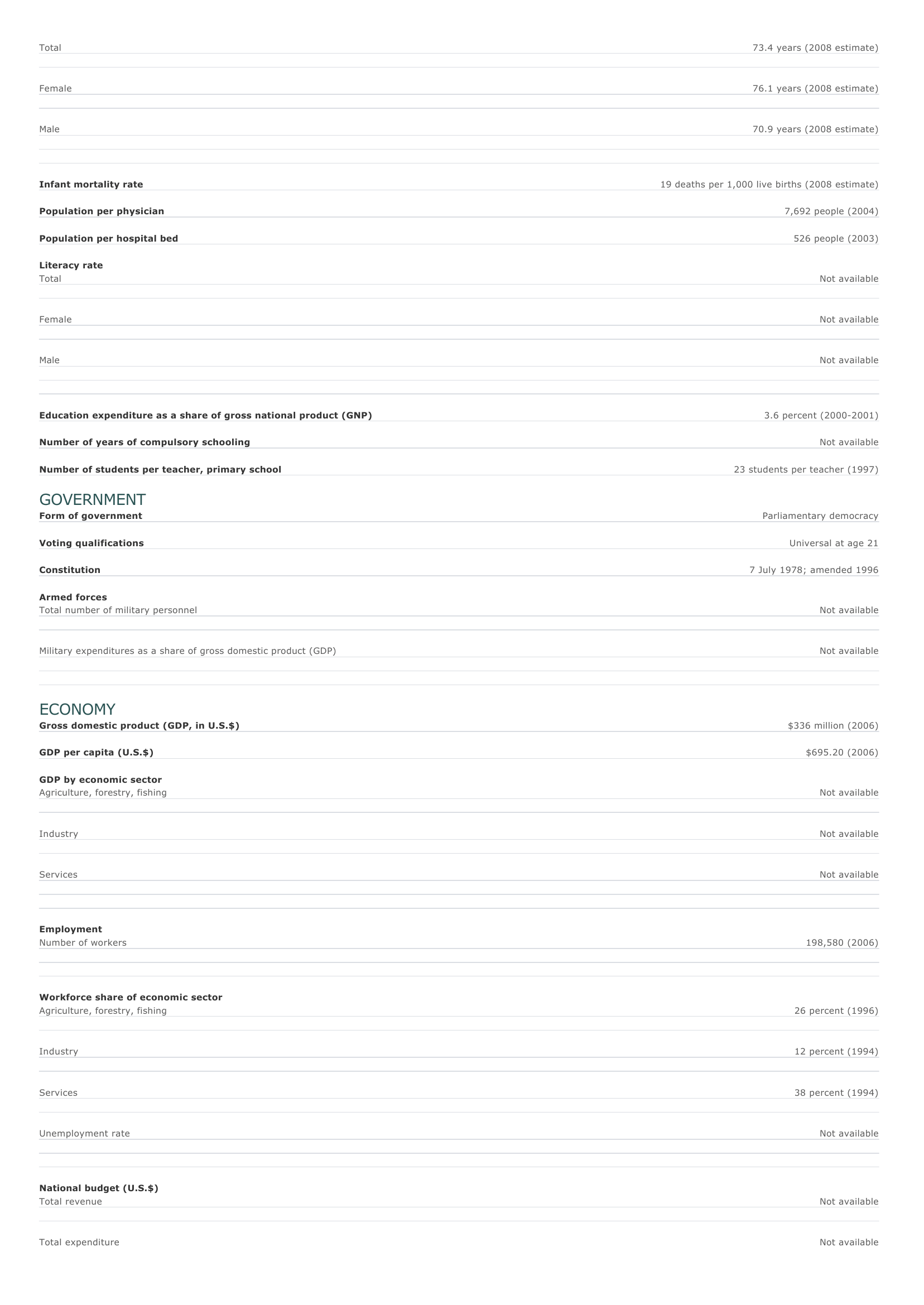Solomon Islands Facts and Figures. BASIC FACTS Official name Capital Area Solomon Islands Honiara 27,556 sq km 10,639 sq mi PEOPLE Population 581,208 (2008 estimate) Population growth Population growth rate 2.47 percent (2008 estimate) Projected population in 2025 815,582 (2025 estimate) Projected population in 2050 1,110,514 (2050 estimate) Population density 21 persons per sq km (2008 estimate) 55 persons per sq mi (2008 estimate) Urban/rural distribution Share urban 17 percent (2005 estimate) Share rural 83 percent (2005 estimate) Largest cities, with population Honiara 56,000 (2003 estimate) Ethnic groups Melanesian 93.0 percent Polynesian 4.0 percent Micronesian 1.5 percent European 0.8 percent Chinese 0.3 percent O ther 0.4 percent Languages Melanesian pidgin, English (official), more than 80 indigenous languages Religious affiliations Anglican 38 percent Protestant 36 percent Roman Catholic 11 percent Indigenous beliefs O ther HEALTH AND EDUCATION Life expectancy 3 percent 12 percent Total 73.4 years (2008 estimate) Female 76.1 years (2008 estimate) Male 70.9 years (2008 estimate) Infant mortality rate Population per physician Population per hospital bed 19 deaths per 1,000 live births (2008 estimate) 7,692 people (2004) 526 people (2003) Literacy rate Total Not available Female Not available Male Not available Education expenditure as a share of gross national product (GNP) Number of years of compulsory schooling Number of students per teacher, primary school 3.6 percent (2000-2001) Not available 23 students per teacher (1997) GOVERNMENT Form of government Parliamentary democracy Voting qualifications Universal at age 21 Constitution 7 July 1978; amended 1996 Armed forces Total number of military personnel Not available Military expenditures as a share of gross domestic product (GDP) Not available ECONOMY Gross domestic product (GDP, in U.S.$) GDP per capita (U.S.$) $336 million (2006) $695.20 (2006) GDP by economic sector Agriculture, forestry, fishing Not available I ndustry Not available Services Not available Employment Number of workers 198,580 (2006) Workforce share of economic sector Agriculture, forestry, fishing 26 percent (1996) I ndustry 12 percent (1994) Services 38 percent (1994) Unemployment rate Not available National budget (U.S.$) Total revenue Not available Total expenditure Not available Monetary unit 1 Solomon Islands dollar (SI$), consisting of 100 cents Major trade partners for exports Japan, South Korea, Thailand, Philippines, and China Major trade partners for imports Australia, Singapore, United States, New Zealand, and Fiji Islands ENERGY, COMMUNICATIONS, AND TRANSPORTATION Electricity production Electricity from thermal sources 100 percent (2003 estimate) Electricity from hydroelectric sources 0 percent (2003 estimate) Electricity from nuclear sources 0 percent (2003 estimate) Electricity from geothermal, solar, and wind sources 0 percent (2003 estimate) Number of radios per 1,000 people 141 (1997) Number of telephones per 1,000 people 16 (2005) Number of televisions per 1,000 people 21 (2000 estimate) Number of Internet hosts per 10,000 people 8.3 (2003) Daily newspaper circulation per 1,000 people Not available Number of motor vehicles per 1,000 people Not available Paved road as a share of total roads 2 percent (1999) SOURCES Basic Facts and People sections Area data are from the statistical bureaus of individual countries. Population, population growth rate, and population projections are from the United States Census Bureau, International Programs Center, International Data Base (IDB) (www.census.gov). Urban and rural population data are from the Food and Agriculture Organization (FAO) of the United Nations (UN), FAOSTAT database (www.fao.org). Largest cities population data and political divisions data are from the statistical bureaus of individual countries. Ethnic divisions and religion data are largely from the latest Central Intelligence Agency (CIA) World Factbook and from various country censuses and reports. Language data are largely from the Ethnologue, Languages of the World, Summer Institute of Linguistics International (www.sil.org). Health and Education section Life expectancy and infant mortality data are from the United States Census Bureau, International Programs Center, International database (IDB) (www.census.gov). Population per physician and population per hospital bed data are from the World Health Organization (WHO) (www.who.int). Education data are from the United Nations Educational, Scientific and Cultural Organization (UNESCO) database (www.unesco.org). Government section Government, independence, legislature, constitution, highest court, and voting qualifications data are largely from various government Web sites, the latest Europa World Yearbook, and the latest Central Intelligence Agency (CIA) World Factbook. The armed forces data is from Military Balance. Economy section Gross domestic product (GDP), GDP per capita, GDP by economic sectors, employment, and national budget data are from the World Bank database (www.worldbank.org). Monetary unit, agriculture, mining, manufacturing, exports, imports, and major trade partner information is from the statistical bureaus of individual countries, latest Europa World Yearbook, and various United Nations and International Monetary Fund (IMF) publications. Energy, Communication, and Transportation section Electricity information is from the Energy Information Administration (EIA) database (www.eia.doe.gov). Radio, telephone, television, and newspaper information is from the United Nations Educational, Scientific and Cultural Organization (UNESCO) database (www.unesco.org). Internet hosts, motor vehicles, and road data are from the World Bank database (www.worldbank.org). Note Figures may not total 100 percent due to rounding. Microsoft ® Encarta ® 2009. © 1993-2008 Microsoft Corporation. All rights reserved.













